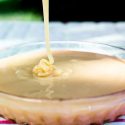Sodium Tripolyphosphate (E451i, STPP) in Food: Uses, Safety, and Side effects

Production | Uses | Safety
Sodium tripolyphosphate (STPP), the sodium salt of the polyphosphate penta-anion, also known as pentasodium tripolyphosphate or sodium triphosphate (different with trisodium phosphate), is a synthetic ingredient mainly used for retaining moisture in fish. The European food additive number for it is E451(i).
How is STPP made?
A polyphosphate is formed by a number of simple phosphate units linked together, and sodium tripolyphosphate contains three such units.
The brief manufacturing processes are as follows (1) :
- STPP is commercially produced by the neutralization of phosphoric acid with sodium hydroxide to form the mixture of monosodium phosphate and disodium phosphate.
- Then heat the mixture to 500-550 °C. Here is the reaction equation: NaH2PO4 + 2Na2HPO4 → Na5P3O10 + 2H2O
Food grade STPP exists as two forms, and follows the corresponding chemical formula:
- STPP Anhydrous: Na5O10P3
- STPP Hexahydrate: Na5O10P3 · 6H2O
Specification
| Other names |
|
| CAS number | 7758-29-4 |
| Appearance | White powder or granular powder |
| Solubility | Soluble in water, insoluble in ethanol |
| PH | 9.1 to 10.2 (1 % solution) |
What are the uses of STPP?
With the capability of maintaining water, the primary uses of food grade sodium tripolyphosphate are to improve the eating quality in food processing, especially in meat and fish products. It is also applied in pet food (e.g. cat and dog food) for the purpose of binding water and keeping the animal feed fresh.
It may also be used as a food starch modifier.
With the functions of chelating metal ions, suspending, dispersing, emulsifying, pH buffering, and etc, technical grade STPP is widely used in the production of laundry detergents & dishwashing detergents, industrial water softener, industrial cleaner, a grease remover, leather pre-tanning agent, dyeing auxiliary agent and so on.
Let’s see its detailed uses in fish and meat.
Fish
STPP is a common ingredient added to fish (e.g. salmon) before frozen and its primary purpose is to reduce the amount of thaw water (or maintain water) and make seafood look firmer and smoother. You may also find it in other frozen seafood, such as scallops, shrimp, and lobster.
The taste, odor, texture, and juiciness are important properties of seafood but most seafood is easily damaged caused by ice crystals and the protein denaturation during the freezing storage.
It is the protein in fish meat that determines the water retention performance. Polyphosphate is a widely used water-retaining agent for seafood to prevent protein denaturation during freezing.
In the production of frozen fish fillets, the fish fillets are soaked in a solution of sodium tripolyphosphate with a certain concentration before freezing.
The level of water retention performance is closely related to the quality of fish products such as texture, tenderness, sliceability, elasticity, and taste. If without sodium tripolyphosphate, when thawed, most seafood is prone to lose weight (water) and generate a darker appearance and as well make the body fragile.
Meat
Phosphate is widely used in meat processing and its main purposes are as follows:
- Water retention, emulsification stability, juiciness and tenderness
- Delaying the rate of oxidative spoilage
- Improving color and maintaining flavor
The phosphates commonly used in meat production include sodium polyphosphate, sodium pyrophosphate and sodium hexametaphosphate.
Polyphosphates are commonly used additives in meat processing. The addition of STPP to meat improves texture & color, reduces cooking loss, and increases product yield. Such a mechanism is believed through increasing pH, strengthening ionic power, and chelating metal ions.
STPP interacts with amino acids or hydroxyl groups in proteins, thus improving the water retention and gel strength of meat.
Meanwhile, its combination with sodium chloride can reduce the sodium content in meat compared with using sodium chloride only. NaCl contains 39.3% sodium, while in sodium tripolyphosphate (anhydrous) the sodium content is only 31.3%.
Is Sodium tripolyphosphate Safe to Eat?
Yes, food grade STPP is a multiple purpose ingredient that is generally recognized as safe (GRAS) when used in food in accordance with good manufacturing practice by the U.S. Food and Drug Administration (FDA) (2).
Also, the safety of STPP has been approved by the European Food Safety Authority (EFSA) and it is an authorized food additive in the European Union (EU) and can be used as a carrier in the preparations of the colour anthocyanins, also applied in the salted fish of the Gadidae family (3), as well as by the Joint FAO/WHO Expert Committee on Food Additives (JECFA) as a sequestrant, texturizer, and thickener. (4)
However, some consumers think it is bad for our health as it is a chemical used in detergents that cannot be eaten, and along with other possible side effects, such as allergy reactions.
Conclusion
Now you may have a good knowledge of the food additive – Sodium Tripolyphosphate (E451i, STPP), from production, uses in fish and meat, approved safety, possible side effects and so on.
Have you noticed this ingredient in the fish shops and seafood restaurants, or in the labels of other kinds of food packagings? Let me know in the comments.



I’ve certainly noticed in fish shops – trays of scallops sitting in a milky white liquid. When I tried to cook the scollops on a hot plate, they oozed rediculous amount so this stuff which made a terrible burnt mess on the plate. I’ll never buy any sort of fish again – turned me off for life.
I have noticed it in Toothpaste – Sensodyne Whitening Formula……when i go back to this brand I always have chapped lips. Wondering if the STTP was the culprit.
It is listed in the ingredients of Mrs. Paul’s frozen Crunchy Breaded Fillets, 1/11/2022
It’s in Swai fish fillets, and I get heartburn after I eat them.
This is a TERRIBLE ingredient in FOOD !
I ended up in bed for 2 days. Symptoms of low BP and hypoglycemia.
It was in wild salmon.
Bought frozen fish filets, noticed they were rubbery slimy and rather clear looking on the edges, it looked so out of the normal, I couldn’t get myself to eat it. Checked ingredients it had tripolyphosphate. Even my cat who loves fish wouldn’t eat it.
As someone who takes Iron supplement does this cause a sulpher like gas in the stomach and major abdominal gas?
Could always eat fish, but within the last 2yrs or so my lips swell up from an obvious allergic reaction. This happened with Safeway salmon (prepackaged), salmon lox(pp also), and restaurant trout. But guess what, NOT from fresh just caught, bought off the pier, Pacific wild salmon. Corporate greed out of control!
After recently starting to research nutrition, I found STTP in a can of Progresso White Clam Sauce! I want to eat clean but Big Food industry won’t let us 🙁
I have not eaten fish, except sardines, since the early 1990s when Sodium tripolyphosphate (STPP) became a common fish additive. I first got sick eating orange roughy fish with STPP in 1987. It took me about two years to figure out why I was getting sick. The Doctors could not figure it out. I would break out in little red splotches (Non-itchy), starting on my limbs and chest then my whole body over several hours. By the next day, it progressed to a very bad flu for about 2 days. It would then begin to resolve with me totally red from head to toe in about 4 days. Fortunately, it did not turn into anaphylactic shock and close my airway.
I now have to check any packaged food to see if it’s added. I never go to fish restaurants anymore since I do not trust that the chef or waiters know what is safe when I ask. I keep reading that I should ask the waiter or fish vendor if the fish is dry (no STPP) or wet ( has STPP). Not one restaurant or store person, in the thirty or so years of asking, knew what dry or wet, meant even after explaining. So I just take my friends to non-fish restaurants and tell them why. They then also often avoid fish restaurants in the future. So I hope fish sellers seeing this learn there is some economic cost to adding STPP besides other health risks such as high sodium leading to high blood pressure.
I went to an allergist for extensive testing and am allergic to nothing else. The allergist knew of the allergy but said it was not well known.
It was in some shrimp I bought – It was salty and didn’t seem right. I ate it. I guess we shall see. I haven’t had any fish in years. More and more I am not buying commercial foods and eat mostly farm bought foods.
Every time we buy salmon we have the skin removed I season it and wrap it in tin foil and bake it slowly then turn on the Broiler to brown it a little. The thing We notice is the white stuff that comes out of the salmon that makes it look as if it is a form of blood coming out of the fish as it is being cooked?
But Now I find Out that is a chemical not natural coming out of the Fish ( salmon ) which makes the meals now something other than Natural???….
It is in some chicken breasts I just bought (frozen in a box). I have had from this producer before with no issues. Just hadn’t checked the label before. 🤔
Oh gosh, just began a sausage subscription from a rare pig breeder, beef, lamb, and milk farm. Must admit the sausage is beautiful as is the raw milk. I usually buy only organic grass fed, and although this is a cow with calf, 100% grass fed, etc I only just asked for the additional sausage ingredients. Unimpressed this is the first of three e-numbers I have researched.
Don’t know how I failed to ask questions prior to buying, but possibly as ‘no soya is fed to the animals’ being shown in the front page detail, my usual thoughts were clouded.
Wondering if this is why I am so lethargic recently!
In the frozen COD i recently purchase. Was wondering why the cod shrinks to nothing portions, now I know why. thank you for enlightening me.
STTP or sodium tripolyphosphate or sodium bentonite or montmorillonite or volcanic ash yes volcanic ash is generally regarded as safe by the FDA ,you heard me right,this stuff needs to be banned
Scallops and other fish fillets shrink by almost 50% after thawing because of this chemical. Consequently, consumers are paying for water at the cost of the main product. I believe this is the main reason why food producers use this product.
Consumers are being ripped off!
To: Steve and Linda Whitelaw, the ingredient in Sensodyne Whitening Formula Toothpaste that is chapping your lips is SLS, it does the same to my lips as well. You can coat your lips with a protective coating of some kind before brushing with it, or buy a safer toothpaste. I use ‘Happy Tooth Hydroxyapatite Toothpaste – Natural, Fluoride Free for Kids, Toddlers & Adults – Whitening, Remineralizing for Sensitive Teeth’ now. I can’t use anything with mint anymore, it burns too much, but Happy Tooth does have a mint toothpaste if you wish it.